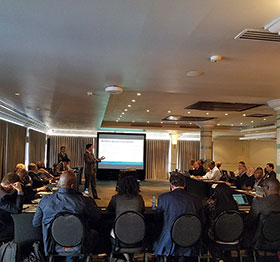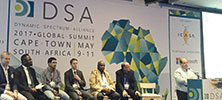

Establishing regulatory frameworks for enabling investment in broadband infrastructure across Africa was the key discussion as the fifth annual Dynamic Spectrum Alliance (DSA) Global Summit, concluded on 11 May in Cape Town.
The three-day event brought together representatives from five continents and 21 countries around the world, including policy makers, regulators, academia, and public and private sector representatives with first-hand experience developing and implementing a range of spectrum-sharing regimes.
“Research from A4AI notes only half of the world (53%) will be connected by 2020, which leaves almost half of the world unconnected, and the United Nations Broadband Commission says being connected is now a basic human right,” commented Professor H Sama Nwana, Emeritus Executive Director, Dynamic Spectrum Alliance, who moderated the panel with senior experts from the Communications Authority of Kenya (CA), the Independent Communications Authority of South Africa (ICASA), the National Communications Authority of Ghana (NCA) and Ultimate Internetworking Solutions (UltiNetS).

Nwana continued: “Investment in infrastructure, unlicensed spectrum and dynamic access technologies remain a barrier to connectivity. It is a challenge of both affordability as well as accessibility, placing the problem squarely with communications policy makers and regulators worldwide. The Global Summit provided a great opportunity to bring together regional policy makers and regulators to share data from their area and explore dynamic spectrum access policies that are already in place and working.”
This year’s summit had high quality presentations resulting in deep discussions on all aspects of spectrum policy, including the challenges around spectrum for Wi-Fi, 5G, the Internet of Things (IoT), closing the digital divide, and satellites. In addition to this, nine regulators came together to share best practices from around the world.
For the first time this year the DSA formally recognised and celebrated the achievements of its members through an awards ceremony. Dr David Crawford, head of the Centre for White Space Communications at the University of Strathclyde, Glasgow, was the recipient of the award for a student-led initiative or research on new opportunities for dynamic spectrum access. Following the Summit, Crawford commented: “It is clear that the dynamic management of spectrum is increasingly being recognised as a key important factor for future wireless connectivity solutions, facilitating more efficient and effective use of spectrum. This will ultimately lead to better and more far-reaching connectivity for a range of applications, including affordable access to the Internet for people in hard-to-reach geographic locations, as well as new IoT and 5G applications and use cases.”
The Dynamic Spectrum Alliance also announced that for the first time it will host the 2018 Global Summit in Europe. “The Dynamic Spectrum Alliance is focused on encouraging policy changes to enable dynamic spectrum access technologies to help make spectrum available in low-, mid- and high-band spectrum to satisfy the requirements of densification and coverage, and do so in cost effective ways to enable successful and sustainable network deployments. During my first Global Summit as President of the DSA, I’m proud of what we have achieved and look forward to seeing the outcomes and progress in the year ahead until we come together again in Europe in 2018,” commented Kalpak Gude, president of the DSA.
For more information visit www.dynamicspectrumalliance.org

© Technews Publishing (Pty) Ltd | All Rights Reserved